Finding the ideal plants for areas prone to drought can take time and effort. But with my list of garden plants for extreme conditions, there is no need to panic.
Drought-resistant plants are the true heroes of a dry spell because they can thrive for weeks or months without human intervention.
Drought-tolerant groundcover plants are incredibly hardy, and once they’ve had a year or two to establish themselves, they will have grown the strong roots they need to survive for many future dry seasons.
Read on to learn more about hardy groundcover plants that could be perfect for your garden hot spots.
Table of Contents
1. Creeping Phlox
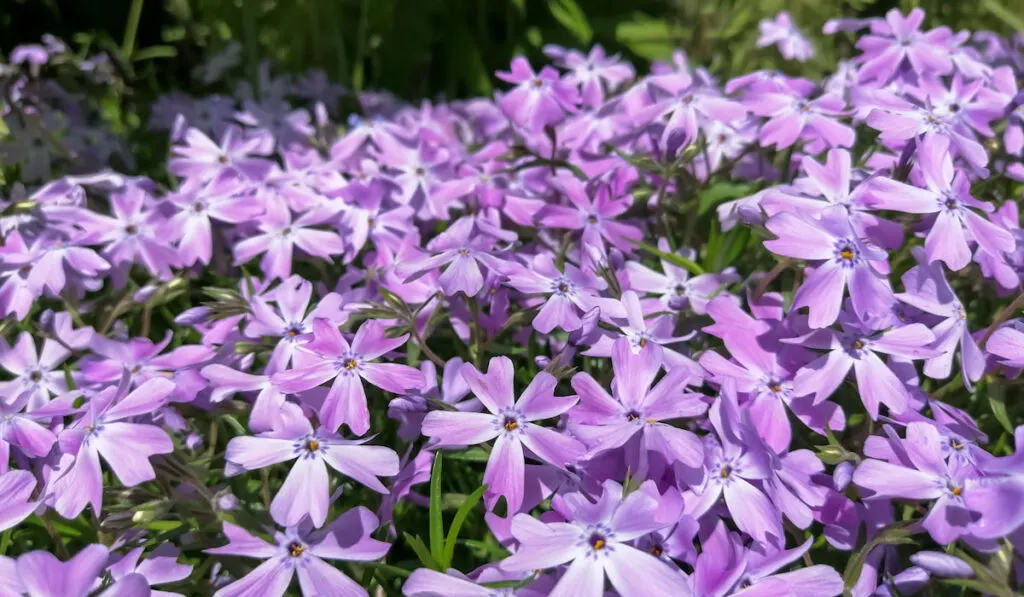
In sunny areas, creeping phlox is one of the most often used groundcovers.
Creeping phlox forms a low-growing, dense blanket of evergreen, needle-shaped foliage. Year after year, its surface area expands at an impressive rate.
Star-shaped flowers bloom in abundance from April through June. Their colors range from white to light lilac, pink to carmine, and purple to light lavender, depending on the variety. Some are even multicolored with an “eye” in the center.
Creeping phlox prefers full sun and well-drained soil and is undemanding and easy to grow. This plant is adaptable enough to flourish in many environments, from rock gardens to flowerbed borders and rooftop gardens.
Key information:
- Hardiness zones: 2-9
- Mature size: 4-6” height; 1-2’ wide
- A full sun lover
- Easy to grow and resistant to drought
- Flowers come in many colors
- It blooms profusely
- Leaves are evergreen and needle-shaped
- Attracts butterflies
2. Aubrieta

Aubrieta is an excellent perennial groundcover for flowerbeds, rockeries, and garden walls. A low plant with a quick and dense spread, Aubrieta can be used to create large garden cushions.
Its most striking feature is its small but abundant blooms which appear in late April and early May. These flowers almost entirely cover the leaves, leaving you with a charming, colorful area in your flowerbed or rockery.
Some varieties continue to flower throughout the summer, but their blooms might not be as strong as when they bloom in the springtime.
The blossom’s color can vary significantly from one type to the next. Pink and purple are the most common colors, but red, blue, and white are also available.
The most interesting varieties of Aubrieta include:
- ‘Blue King‘ – large blue flowers
- ‘Cascade Purple‘ – large red-pink flowers
- ‘Bressingham Pink‘ – large, dark pink flowers
- ‘Red Carpet‘ – dark red flowers
- ‘Winterberg‘ – white flowers
Dense, partly evergreen, slightly hairy leaves continue to be the crowning glory of the Aubrieta throughout the remainder of the season, where they form beautiful, soft cushions along the garden.
Sunlight, heat, and dry soil are all essential for the growth of Aubrieta. It thrives in full sun and well-drained soil.
Aubrieta is a hardy groundcover plant and does not usually need winter cover.
Key information:
- Hardiness zones: 4-8
- Mature size: 6-8” height; 1-2’ wide
- Prefers full sun locations
- Heavy blooming
- Flowers come in many colors
- Grows quickly
- Soil tolerant
- Drought and heat tolerant
- Low cultivation requirements
3. Creeping Thyme

Creeping thyme is a perennial plant that thrives in its natural environment and garden settings. Creeping thyme often grows in wooded areas or open fields. So how to recognize it?
Creeping thyme can easily be identified by its intense fragrance, and its tiny, pinkish-purple flowers that bloom from June to October.
Creeping thyme is a superb plant for covering the ground and will provide a gorgeous blanket appearance in the garden when allowed to develop to its full potential.
Since its origins in the Mediterranean, creeping thyme has thrived in hot, sunny climates. It can be grown in small spaces like rockeries, between pavers, or on slopes because it requires little maintenance.
While using it to cover the ground between flowers, it also keeps the soil from drying out too much. Another bonus point is that this groundcover plant also stops the growth of weeds.
Thyme’s pungent smell repels aphids and snails, so I recommend growing it around vegetable beds.
Thyme is a great spice often used in cooking. It goes well with tomatoes, various kinds of meat, sausages, and foods high in fat. Not only does it taste nice, but it will also speed up your metabolism.
Key information:
- Hardiness zones: 5-9
- Mature size: 2-3” height; 10″-1’ wide
- A full sun lover
- Heavy blooming
- Grows quickly
- Soil tolerant
- Low cultivation requirements
- Flowers attract butterflies and bees
- Recipient of the Award of Garden Merit (AGM)
4. Sedum
Even though some Sedum species can grow up to 30 inches tall, most of these hardy perennials are low groundcover plants.
Sedum is ideal for use in low-maintenance environments like rock gardens and green roofs due to its low water requirements and a high tolerance for neglect.
The undeniable advantage of sedum is the long-lasting and attractive foliage. Sedums survive dryness, poor soil, and, in most cases, temperature drops.
Key information:
- Sedum is a genus with more than 400 species
- Flowers come in shades of pink, purple, burgundy, and green
- Leaves are different shapes, sizes, and colors depending on the variety
- Prefers full sun locations
- Grows quickly
- Soil tolerant
- Drought and heat tolerant
- Low cultivation requirements
- Attractive through the winter
- Flowers attract butterflies and bees
5. Sedum ‘Blue Pearl’
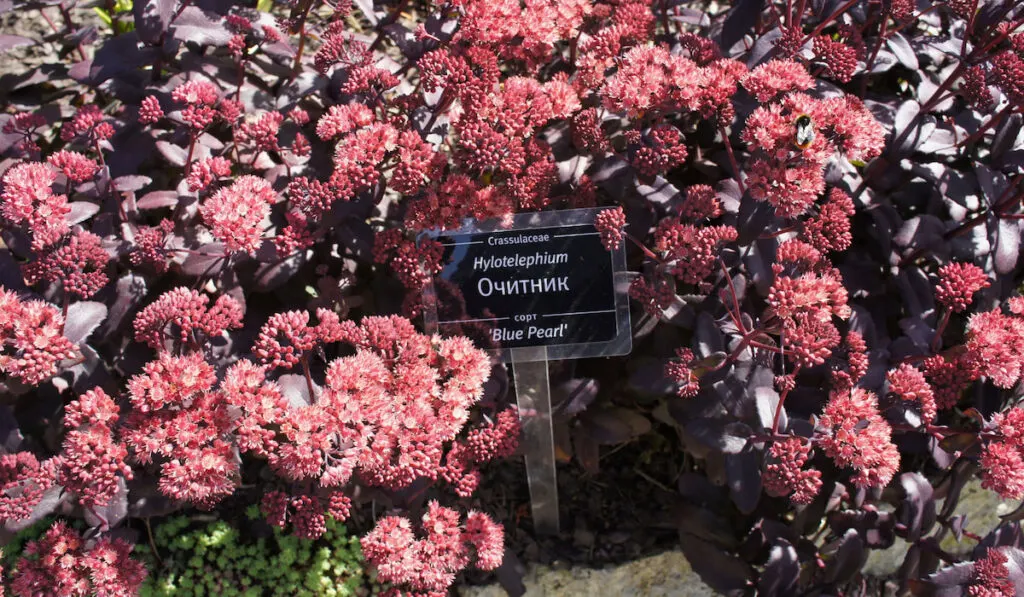
Sedum ‘Blue Pearl’ grows up to 15 inches in height, and its leaves take on a blue tint.
The variety is distinctive not only because of its striking smokey blue color but also because the upright stems are stiff and strong, and the leaves are particularly big.
The leaf blade is round and begins with a hue of purple olive before turning a rich blue with a waxy coating later in the summer.
With its dark blue leaves and bright pink flowers that bloom in August, Sedum ‘Blue Pearl’ forms a stunning arrangement.
6. Sedum ‘Little Miss Sunshine’
‘Little Miss Sunshine’ is a hardy perennial plant that will return year after year due to its incredible resilience and abundant blooming. It is a great accent in any design, from sunny borders to rocky gardens.
‘Little Miss Sunshine’ reaches a height of 6–8 inches and can be used to make low, dense, and practical garden carpets.
Dark green, glossy, round leaves with serrated margins cover the perennial shoots.
From June to July, lovely star-shaped yellow blooms occur in delightful clusters above the crown of lush foliage.
7. Sedum ‘Spectabile’

Because of its size, Sedum ‘Spectabile’ stands out among sedums. The average height of a fully mature plant is 1 to 2 feet.
Like all sedums, it is a low-maintenance plant that requires a sunny site and well-drained soil. Sedum ‘Spectabile’ truly shines when it forms large, compact clumps.
The plant is covered in umbrella-shaped clusters of small pink or carmine blooms in August and September.
8. Cerastium tomentosum ‘Snow-in-Summer’
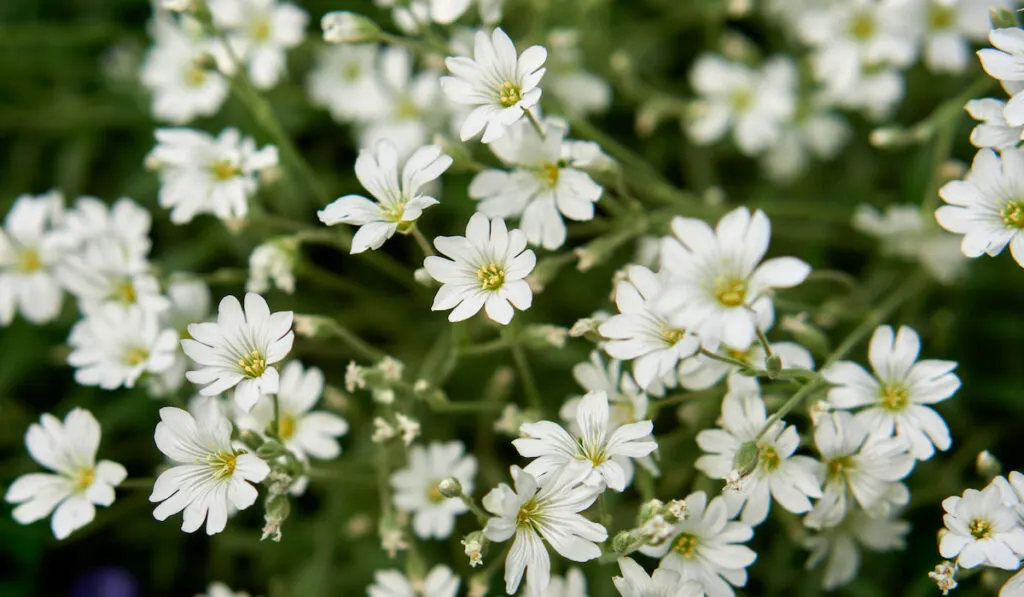
‘Snow-in-Summer’ is a commonly cultivated, undemanding, groundcover perennial. It is valued for its attractive foliage and numerous tiny flowers while in bloom.
The leaves are velvety, pleasant to the touch, with a bluish tint. The flowers are snow-white, with deeply cut petals gathered in loose clusters raised above the leaves.
The abundant flowers of the ‘Snow-in-Summer’ plant give the illusion of snowfall, hence the name.
Blooming time is May through June, but it is best to get rid of the withered inflorescences when the flowers are done blooming.
‘Snow-in-Summer’ grows to a height of around 6 inches and develops dense carpets quite quickly.
‘Snow-in-Summer’ may thrive even in the harshest climates and has low soil needs. It grows well even on barren ground and in dry soil. The plant is entirely frost-resistant.
The main thing that ‘Snow-in-Summer’ requires for healthy growth is a lot of sun. It looks its best when planted on rock walls and slopes, where it easily overgrows the gaps between the stones. It spreads quickly, making it an excellent choice for covering vast areas.
Key information:
- Hardiness zones: 5-9
- Mature size: 6”-1’ height; 6”-2’ wide
- Prefers full sun locations
- Heavy blooming
- White small flowers
- Grows quickly
- Soil tolerant
- Drought and heat tolerant
- Low cultivation requirements
9. Dwarf Plumbago

Dwarf plumbago is still a little-known perennial plant worth having due to its ornamental value and ease of cultivation.
It will provide beauty to the garden in the late summer and fall when most other plants prepare for dormancy.
Blue flowers begin to open around the end of August and stay in full bloom through the end of October. In the fall, the leaves of Dwarf Plumbago turn a beautiful shade of reddish-brown, which is an additional bonus to the scenery.
Dwarf plumbagoes thrive in well-drained soil and full sun to partial shade. It’s a great filler between shrubs and flowerbeds, rock gardens, borders, and even pots.
The vivid hue of the blooms and leaves adds a charming accent to every composition.
Key information:
- Hardiness zones: 5-9
- Mature size: 9″-1′ height; 1-2’ wide
- A full sun lover
- It is easy to grow, and resistant to drought
- Flowers come azure-blue
- Leaves turn red-brown hue in autumn
- Recipient of the Award of Garden Merit (AGM)
10. Delosperma
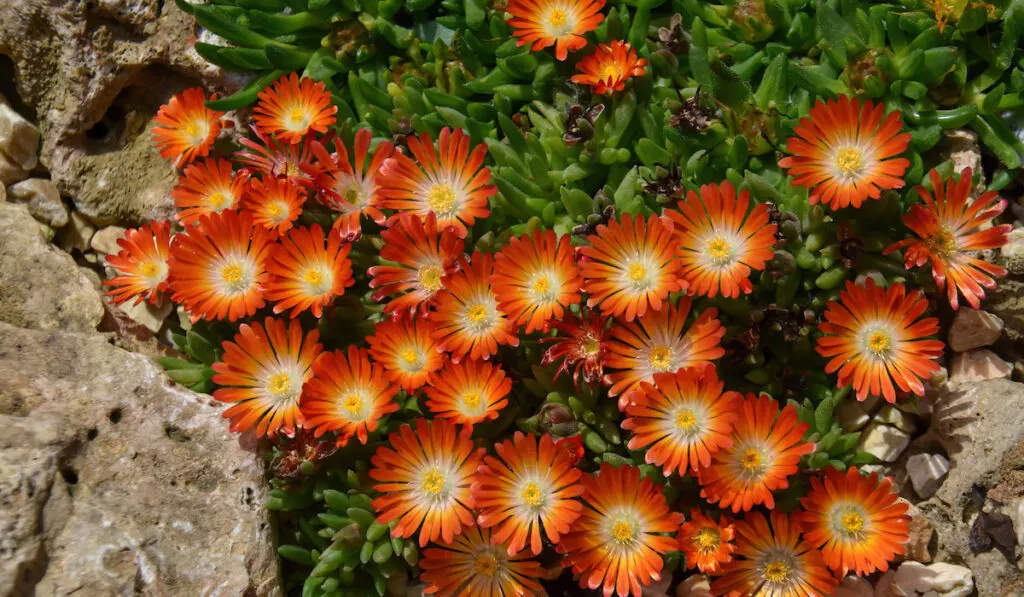
Delosperma is a small succulent perennial from Africa. Depending on the species, they can have a broad spectrum of colors, from white to yellow, red, orange, or pinkish purple.
Delosperma starts blooming in late May or early June and doesn’t stop until the fall. It has tiny flowers that look like aster blossoms.
The flowers’ sensitivity to light is unique, as their blossoms open only on bright days, remaining closed at night and during cloudy weather.
Delosperma cultivation is simple if the plant gets the proper growing conditions. Delosperma, like other succulents, demands a warm, protected, and sunny garden. It also needs a porous substrate, preferably with gravel or sandy soil.
It can survive in dry conditions, but it can’t stand too much water, which could be a problem in the winter.
Due to its resistance to drought, delosperma is perfect for growing on rockeries, slopes, and low walls. It blooms wonderfully throughout the summer.
Key information:
- Hardiness zones: 6-10
- Mature size: 2-3” height; 1-2’ wide
- A full sun lover
- It is easy to grow and resistant to drought and heat
- Soil tolerant
- Flowers come in many colors, like white, orange, yellow, and pink
- Their blossoms open only on bright days
11. Vinca minor ‘Bowle’s Variety’
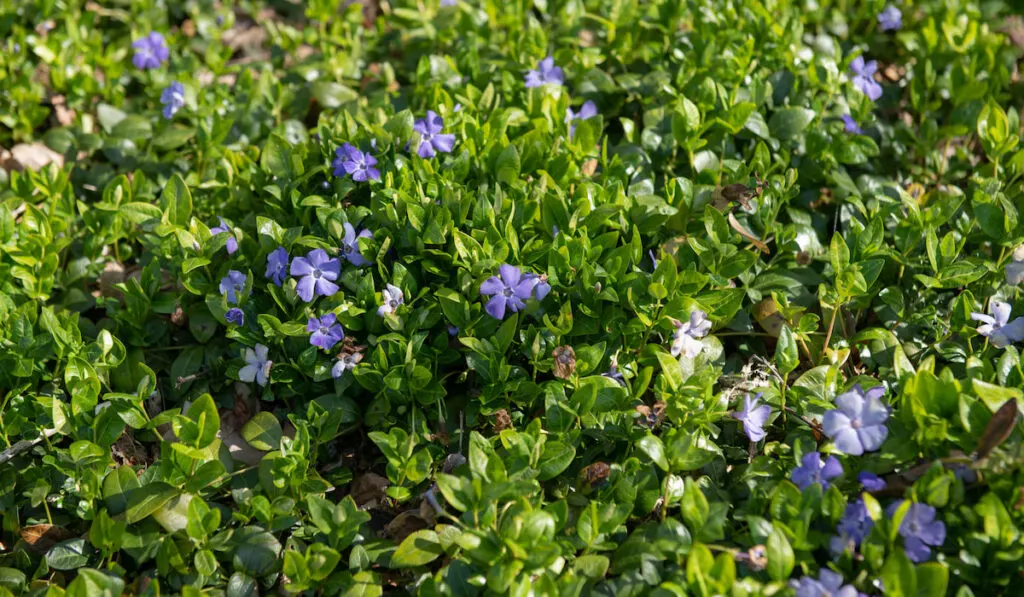
Vinca minor ‘Bowle’s Variety,’ also known as periwinkle, is a low cultivation cover plant that grows quickly.
Periwinkle is simple to grow and can be planted in full sun, light shade, or shadow.
‘Bowle’s Variety’ has evergreen, small, elliptical, stiff leaves, tightly covering the whole plant even in winter.
It blooms blue at the end of April, and the fact that it repeats flowering at the end of summer makes it a valuable cover plant.
‘Bowle’s Variety’ spreads quickly, doesn’t need much care, and is resistant to frost. It will feel best in soil that drains well, but any type of soil will do.
Key information:
- Hardiness zones: 4-10
- Mature size: 4-6” height; 1-2’ wide
- A plant that can grow in full sun, light shade, or shade
- Purple-blue small flowers
- Evergreen, small, stiff leaves
- Grows quickly
- Soil tolerant
- Low cultivation requirements
- Robust and healthy
- Recipient of the Award of Garden Merit (AGM)
Final Thoughts
Finding plants that will survive in sun-scorched sandy soils is a common problem. Luckily, there are many drought-tolerant plant species available that look great. They also thrive in gardens with poor soil in sunny areas.
Among these drought-tolerant species, you will find easy-to-grow groundcover plants such as stunning succulents and pretty perennials.
With such a wide range of beautiful plants that have a reputation for surviving in harsh conditions, there is no limit to how colorful and vibrant your garden can be!
Resources
Both my wife and I are gardening enthusiasts and we have many species of plants and vegetables in our garden. Some of the information in this article is from my own experience.
- https://www.rhs.org.uk/plants/trials-awards/award-of-garden-merit
- https://www.gardenia.net/plant/phlox-subulata-coral-eye
- https://en.wikipedia.org/wiki/Aubrieta;
- https://www.nature-and-garden.com/gardening/aubrieta.html;
- https://www.gardeningknowhow.com/ornamental/groundcover/aubrieta/how-to-grow-aubrieta-plants.htm
- https://www.gardenia.net/plant/thymus-coccineus-group
- https://www.aucklandbotanicgardens.co.nz/plants-for-auckland/plants/sedum-spectabile/
- https://www.cottagefarmsdirect.com/Product/new-category-11/blue-pearl-sunsparkler-sedum-3pc-62?AspxAutoDetectCookieSupport=1
- https://www.gardenia.net/plant/sedum-little-miss-sunshine
- https://www.gardenia.net/plant/cerastium-tomentosum-snow-in-summer
- https://www.gardenia.net/plant/ceratostigma-plumbaginoides
- http://pza.sanbi.org/delosperma
- https://www.gardenia.net/plant/vinca-minor-bowles-variety-periwinkle
